
Back بوابة:رسوم متحركة Arabic دەروازە:ئەنیمەیشن CKB Portal:Animation German درگاه:پویانمایی Persian Portail:Animation French Portale:Animazione Italian Portal:アニメ Japanese 포털:애니메이션 Korean Portal:Animação Portuguese Портал:Мультипликация Russian

| Main | Categories and topics | Tasks and projects |
Introduction
Animation is a filmmaking technique by which still images are manipulated to create moving images. In traditional animation, images are drawn or painted by hand on transparent celluloid sheets (cels) to be photographed and exhibited on film. Animation has been recognized as an artistic medium, specifically within the entertainment industry. Many animations are computer animations made with computer-generated imagery (CGI). Stop motion animation, in particular claymation, has continued to exist alongside these other forms.
Animation is contrasted with live-action film, although the two do not exist in isolation. Many moviemakers have produced films that are a hybrid of the two. As CGI increasingly approximates photographic imagery, filmmakers can easily composite 3D animations into their film rather than using practical effects for showy visual effects (VFX). (Full article...)
Selected article
WALL-E is a 2008 American computer-animated science fiction film produced by Pixar Animation Studios and directed by Andrew Stanton. The story follows a robot named WALL-E, who is designed to clean up a waste-covered Earth far in the future. He eventually falls in love with another robot named EVE, and follows her into outer space on an adventure that changes the destiny of both his kind and humanity. After directing Finding Nemo, Stanton felt Pixar had created believable simulations of underwater physics and was willing to direct a film largely set in space. Most of the characters do not have actual human voices, but instead communicate with body language and robotic sounds, designed by Ben Burtt, that resemble voices. Walt Disney Pictures released it in the United States and Canada on June 27, 2008. The film grossed US$23.1 million on its opening day, and $63 million during its opening weekend in 3,992 theaters, ranking #1 at the box office. Following Pixar tradition, WALL-E was paired with a short film, Presto, for its theatrical release. WALL-E has been met with overwhelmingly positive reviews among critics. It grossed $534 million worldwide, won the 2008 Golden Globe Award for Best Animated Feature Film, the 2009 Hugo Award for Best Dramatic Presentation, Long Form, the Academy Award for Best Animated Feature as well as being nominated for five other Academy Awards at the 81st Academy Awards. WALL-E ranks first in TIME's "Best Movies of the Decade."
Selected image
Did you know (auto-generated) -

- ... that the Tuca & Bertie episode "The Jelly Lakes" employs a paper-cutout animation that helps to depict abuse in a way that centers the victim's story?
- ... that the live-action comedy series Community had a stop motion animated Christmas special?
- ... that, for the animated film Us Again, director and writer Zach Parrish considered a video of an elderly couple dancing to be visceral and ideal inspiration?
- ... that the first lady of the Ivory Coast created an animated kids' show in 1989?
- ... that the 1937 Fleischer Studios strike in New York City was the first major labor strike in the animation industry?
- ... that the Pakistani film Shehr e Tabassum was the first animated cyberpunk film to be made by an Urdu development team?
Selected quote
Selected biography
Steven Ross Purcell (born 1961) is an American cartoonist, animator and game designer. He is most widely known as the creator of Sam & Max, an independent comic book series about a pair of anthropomorphic animal vigilantes and private investigators, for which Purcell received an Eisner Award in 2007. The series has since grown to incorporate an animated television series and several video games. He performed freelance work for Marvel Comics and Fishwrap Productions before publishing his first Sam & Max comic in 1987. Purcell was hired by LucasArts as an artist and animator in 1988, working on several titles within the company's adventure games era. Purcell collaborated with Nelvana to create a Sam & Max television series in 1997, and briefly worked as an animator for Industrial Light & Magic after leaving LucasArts. He is currently employed in the story development department at Pixar. His main work for the animation studio has been with the 2006 film Cars and spin-off materials such as shorts and video games. Despite his employment with Pixar, Purcell has continued to work with comic books and came together with Telltale Games in 2005 to bring about new series of Sam & Max video games.
Selected list
Walt Disney (1901–66) won or received a total of twenty-six Academy Awards, and holds the record for most Academy Awards in history. He won a total of twenty-two competitive Academy Awards from a total of fifty-nine nominations, and also holds the records for most wins and most nominations for an individual in history. Disney won his first competitive Academy Award and received his first Honorary Academy Award at the 5th Academy Awards (1932). He received the Honorary Academy Award for the creation of Mickey Mouse and won the Academy Award for Best Short Subject (Cartoon) for the film Flowers and Trees. In the seven Academy Award ceremonies that followed (6th–12th), Disney consecutively earned nominations and won in the same category. Disney received three more Honorary Academy Awards, one in 1939 and two in 1942. He was posthumously awarded his final Academy Award in 1969.
More did you know...
- ...that animator Nickson Fong is the first Singaporean to receive an Academy Award?
- ...that combining computer animation with live action, Adhisaya Ulagam 3D was the first 3D Indian film that featured dinosaurs?
- ...that Roger Ebert said the animated documentary film Ryan "is hard to describe, impossible to forget"?
Anniversaries for August 15
- Films released
- 1923 – Felix Laughs Last (United States)
- 1925 – Alice's Tin Pony (United States)
- 1925 – Felix Dopes it Out (United States)
- 1927 – Bee Cause (United States)
- 1929 – Ratskin (United States)
- 1932 – Lighthouse Keeping (United States)
- 1952 – Tots of Fun (United States)
- 1959 – Cat's Paw (United States)
- 2008 – Star Wars: The Clone Wars (Lucasfilm Animation, Warner Bros., United States)
- Television series and specials
- 1994 – The Brothers Grunt, an American animated television series begins airing on MTV
- 1998 – Donkey Kong Country, an American animated television series begins airing on Fox
Subportals
Related portals
Wikimedia
The following Wikimedia Foundation sister projects provide more on this subject:
-
Commons
Free media repository -
Wikibooks
Free textbooks and manuals -
Wikidata
Free knowledge base -
Wikinews
Free-content news -
Wikiquote
Collection of quotations -
Wikisource
Free-content library -
Wikiversity
Free learning tools -
Wiktionary
Dictionary and thesaurus
© MMXXIII Rich X Search. We shall prevail. All rights reserved. Rich X Search
























